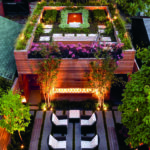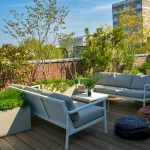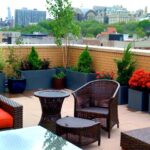Roof gardens have become a popular trend in urban areas as a way to maximize outdoor space and create a green oasis in the midst of city living. A well-designed roof garden can provide numerous benefits, from reducing energy costs to improving air quality and providing a peaceful retreat from the hustle and bustle of everyday life.
When it comes to designing a roof garden, there are several key factors to consider. First and foremost, it’s important to assess the structural integrity of the roof to ensure it can support the weight of a garden. Consulting with a structural engineer is recommended to determine the load-bearing capacity of the roof and any necessary reinforcements that may be required.
Another important consideration in roof garden design is the choice of plants and landscaping elements. Selecting drought-tolerant plants that can thrive in the harsh conditions of a rooftop environment is essential. Succulents, ornamental grasses, and native plants are popular choices for roof gardens, as they require minimal water and maintenance.
Incorporating hardscape elements such as pathways, seating areas, and container gardens can help define the space and create a cohesive design. Using sustainable materials like recycled wood, composite decking, and permeable pavers can enhance the eco-friendly aspect of a roof garden while adding visual interest and functionality.
Lighting is another crucial aspect of roof garden design, especially for those who plan to use the space in the evening or at night. Sconces, string lights, and lanterns can create a warm and inviting atmosphere, while solar-powered lights are a sustainable option for illuminating the garden without the need for electricity.
Finally, irrigation and drainage are important considerations when designing a roof garden. Installing a drip irrigation system can help conserve water and ensure plants receive the proper amount of moisture. Proper drainage is also crucial to prevent water damage to the roof and building structure, so incorporating a drainage system or using elevated planters with built-in drainage is recommended. With careful planning and attention to detail, a well-designed roof garden can transform an unused rooftop into a beautiful and functional outdoor space that enhances the quality of life for urban dwellers.
















